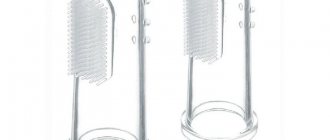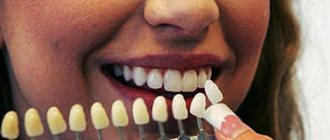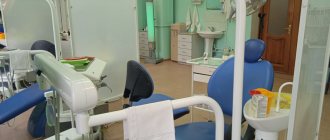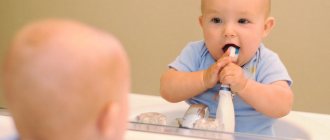The period of childhood when a child delights you with his toothless smile passes about five months after birth: at this time teething usually begins. Between the sixth and eighth months of life, the central incisors of the lower jaw begin to appear, and then the upper. By 8-12 months - lateral incisors, first on the lower and then on the upper jaw. By 12-16 months, temporary chewing teeth erupt, by 16-20 months - canines, and by 20-30 months - second chewing teeth, which complete the formation of the primary bite.
Why should you brush your baby teeth?
Many young mothers believe that brushing their baby teeth is not necessary because they will fall out anyway. However, decaying teeth
are always pain, discomfort and a source of spread of pathogenic bacteria.
How to brush your teeth correctly
How often, what to use, and in what mode is it better to brush your teeth? Detailed instructions for children and adults.
In addition, the early habit of brushing teeth becomes natural for the child and will help him preserve the health of his molars.
Silvering of teeth: is it a panacea?
At the first manifestations of caries, doctors recommend silvering. A 30% silver solution is applied to the teeth with a cotton swab, which creates a protective film. The manipulations are repeated three times with an interval of 2-7 days. You cannot eat, drink or rinse your mouth for 40 minutes after the procedure. 3-5 courses are recommended throughout the year, because the “film” gradually loses its protective function under the influence of acid. Silvering is carried out only on teeth that are not affected by visible caries. Otherwise, silver coating leads to the death of soft tooth tissue. Due to the high concentration of silver nitrates, it is not recommended to do silver plating at home, so as not to get a burn to the mucous membrane. It is important to remember that silvering is not a treatment, but a prevention of caries.
How are the first teeth cut?
Teaching your child the rules of personal hygiene
Children are taught hygiene procedures from the first days of life. Find out how to teach your child to practice personal hygiene on his own.
The main symptoms of teething in infants are increased salivation and swelling of the gums.
The process is usually uncomfortable for the child and may be accompanied by increased moodiness and crying for no reason, insomnia and loss of appetite. A slight increase in temperature
(up to 38°C) may be a natural protective reaction of the body, but in this case the child should be shown to a doctor.
You can help the baby a little. Buy several teethers
- rubber or plastic toys for the child to bite on.
Chewing rings with liquid inside, which are first placed in the refrigerator to cool, has a particularly soothing effect. Additional methods
: Gently massage the baby's gums with a gauze pad soaked in cold water, or use baby teething gels with anesthetics, which the pediatrician will recommend.
For expectant mothers
teeth
are formed
during the prenatal period.
At the end of the first and beginning of the second trimester. Therefore, mothers’ diet during this period should contain a sufficient amount of vitamins and microelements
. Teeth need calcium, vitamin B, fluoride and phosphorus, so the diet must include dairy products, vegetables and fruits, meat and fish, eggs and nuts. If the expectant mother has severe toxicosis, the lack of vitamins and minerals must be added in the form of pharmaceutical preparations.
What foods are good for your first teeth?
Foods rich in calcium
.
First of all, it is cottage cheese and hard cheese. Slightly less calcium is found in milk, fermented milk products, green leafy vegetables, gooseberries, currants, and cherries. Sources of vitamin D, without which calcium cannot be absorbed, are egg yolk and butter. You should include carbohydrate foods in your child’s diet less often: bread, potatoes, and especially sugar and sweet foods. Sweets provoke the active proliferation of bacteria in the mouth, which leads to early caries
. “The longer you don’t offer your child sweets, the better,” says Kuznetsova, “for example, children under three years old should not be given chocolate at all.”
Exposing bottleneck caries
Young mothers are surprised to hear from the dentist that a child of the first or second year of life has caries. "Where?" - asks every mother who has encountered this. “From the breast or a bottle,” the doctors answer.
The fact is that acid attacks tooth enamel every day and destroys it. Bacteria penetrate the destroyed enamel and continue to destroy the tooth. Acid, first of all, is given to us by carbohydrates, which are found in juices, fruit drinks, infant formula and even, attention, breast milk! By treating the child to juice or formula from a bottle when the child wakes up at night, or by exposing her breasts, the mother nullifies evening brushing of teeth and allows bacteria to do their destructive work. To avoid bottle caries, you must:
- Careful oral hygiene;
- Gradually cancel night feedings, offering your child to drink water.
How to care for baby teeth?
From the moment the first baby teeth appear (6-8 months)
, and up to a year, parents should brush the child’s teeth with a special silicone brush placed on a finger at least once a day.
From the age of one year,
a child can brush his teeth twice a day with a very soft children's toothbrush, moving from the gums to the cutting edge or chewing surface of the teeth.
From 2-2.5 years old,
children's gel toothpaste should be used.
The amount of paste per cleaning should not exceed the size of a pea. From the age of 3,
children's teeth are brushed twice a day with a very soft toothbrush and children's toothpaste.
From the age of 2-3 years
, a child can be taught to brush his teeth independently under the mandatory supervision of his parents.
Let's look into your mouth
Once a week, look into your favorite child’s mouth, because you can see a lot of “interesting things” there. White sores in a child’s mouth may be a warning sign. If the child does not eat well, stomatitis is likely, since when they come into contact with food or the tongue, these ulcers hurt and do not allow them to chew normally.
For a newborn, candidal stomatitis, which is caused by candida fungus, becomes an unpleasant scourge. A white film similar to milk deposits is visible in the mouth. Some parents mistake it for swollen gums. In this case, see your pediatrician, as untreated fungus can lead to meningitis and kidney damage.
Chicken pox differs from stomatitis, in which blisters filled with liquid appear in the mouth. Swallowing becomes very difficult and eating becomes difficult. Sometimes smallpox is accompanied by fever. There is no need to put off visiting a doctor.
Another common problem is tooth decay, which can easily be confused with plaque after eating. If you notice brown spots (even tiny ones) on your teeth, take your child to the dentist. Baby tooth caries is treated in one visit, easily and quickly, most often without an injection. But advanced caries, which has affected a large part of the tooth, will have to be treated in two or three visits, using local anesthesia.
Choosing a brush and toothpaste for your baby
How to choose a toothbrush
Conventional, electric or ultrasonic? Soft or hard? Synthetic or natural? Accurate answers to all questions.
A baby toothbrush looks like this.
It has a short working part - from 18 to 25 mm. Until the age of five, a child has a brush with very soft (extra soft) synthetic bristles, and from a later age - with soft bristles with rounded ends. The handle of the children's brush is thicker, with non-slip inserts - this makes it easier for the baby to hold it. Children's toothpastes
are also different from adults. They are low in abrasives, low in fluoride, and contain fruity fragrances and flavors. Look carefully at what age of children this or that toothpaste is intended for.
Healthy food for teeth
Parents must definitely tell and show the baby how to care for the first baby teeth, because... Their condition depends on the quality of care. There are two points to pay attention to:
- Child nutrition;
- teeth cleaning.
By the age of three, children already have all their baby teeth, but the importance of proper nutrition for teeth is still relevant. It is recommended to provide the child with foods containing large amounts of calcium - the main building material for bones and teeth. The absorption of calcium in the child’s body occurs in the presence of a sufficient amount of vitamin D. Products containing the necessary components are the entire range of dairy products, butter, vegetables and berries, and egg yolk. The child can also take vitamins that are beneficial for children’s teeth - as a rule, they are part of vitamin complexes.
There are also foods that, due to the large amount of carbohydrates they contain, can become an indirect cause of such dental problems as caries. In particular, eating sweets stimulates the active development of pathogenic bacteria in the oral cavity. It is not necessary for your child to completely give up sweets; it is enough to simply make it a rule to brush your teeth or rinse your mouth after dessert. Although some experts categorically advise not to give children sweet foods, caring parents will not leave their child without such pleasure, moreover, it is even necessary in moderation.
What parents need to remember
The baby should see the dentist for the first time at six months, and the first tooth should be cleaned with a special brush.
Sweets harm the first teeth, but daily brushing with a special children's brush and toothpaste is beneficial. Tags:
- Hygiene
- Teeth
- Preschoolers
- Babies
- Kuzmina
3 comments • To leave a comment you must be an authorized user
- few Hello everyone. I wanted to recommend a cool service to you. Using this service, you can find out for free on your phone. You can also read reviews about the numbers or leave your own if a scammer calls you. Thank you for reading my post. I create useful services for people. https://kto-zvonil.net https://kto-zvonil.net https://kto-zvonil.net https://kto-zvonil.net https://kto-zvonil.net https://kto -zvonil.net https://kto-zvonil.net https://kto-zvonil.net https://kto-zvonil.net https://kto-zvonil.net
- tancuet massage "methods: gently massage the gums"
- irina_golovleva at 6-8 months a child can be given hard cheese, gooseberries, currants, cherries???????!!!!!!!!!!!!!!!!!!!!!!!!!!! !!!
Everything you need to know about bite
A child's permanent bite is formed at the age of 12-15, when the molars replace the baby teeth. Before this, children experience a period of formed temporary occlusion, when the jaw bones grow and preparations for changing teeth occur. At the age of 3-4 years, it is necessary to see an orthodontist who is involved in the prevention of correct bites and corrects incorrect bites. There are criteria by which it is easy to understand that a child’s bite is incorrect:
- the upper lip is protruding.
- the lower jaw is pushed forward.
- crooked teeth and incomplete contact.
- mismatch of the boundaries of opposite chewing surfaces: the upper chewing teeth, when closing the jaw, fall past the lower ones and vice versa. The front teeth, on the contrary, should not be at the same level - correctly positioned upper teeth overlap the lower ones by 1-2 mm.
If you notice any of the following in your child, contact an orthodontist who will help straighten the bite with:
- Installation of the plate, which is made individually based on a previously taken photograph.
- Trainer. Indicated for problems: bruxism, minor changes in bite, the period after using braces.
- Positioner. Maintains a corrected bite and maintains the jaw in the desired position.
- Braces. They help straighten teeth and correct bites; the child wears them for six months. The wearing time is discussed individually.
- Prosthetics of baby teeth. There are removable and fixed dentures. They are used in case of severe tooth decay by caries, tooth root fracture, premature loss, to allow the jaw to develop normally before the appearance of permanent teeth.
What affects the timing of teething?
Processes in the body are individual, including timing. The age at which the first teeth appear is determined by a number of factors:
- Heredity.
- The intrauterine period and negative factors affecting the fetus (for example, a pregnant woman taking certain medications).
- Nutrition for the expectant mother during the period of waiting for the baby and breastfeeding.
Introduction of complementary foods, etc.










